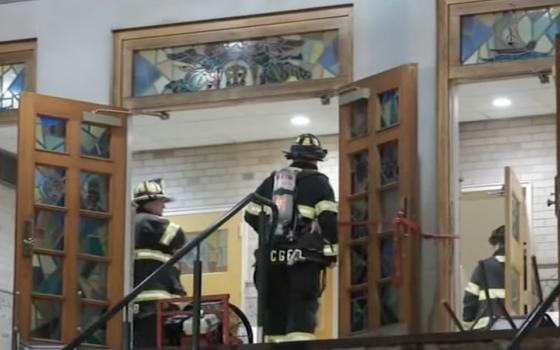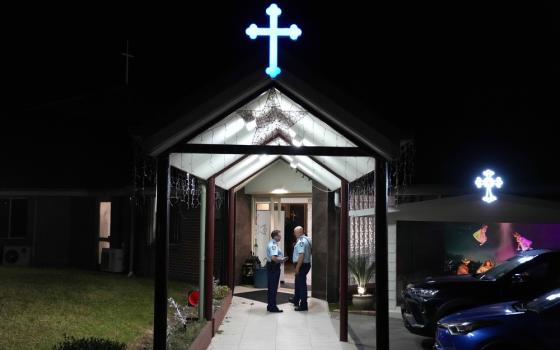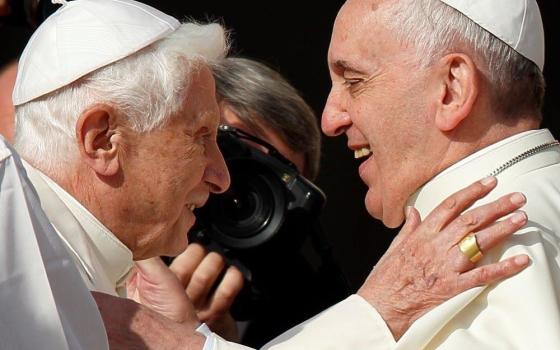Late last week, a new iPhone app designed to help Catholics prepare for the confessional made its debut. The app tailors its questions to a person’s gender and vocation. So if you punch in both “female” and “priest,” you immediately receive the message “sex and vocation are incompatible.”
The women and men featured in the new documentary Pink Smoke would beg to differ.
This weekend Pink Smoke had its debut as part of the Athena film festival hosted by Barnard College in New York. The film had been screened previously at the national Call to Action conference last November. The documentary chronicles the fight against the injustice of the ban on women’s ordination in the Roman Catholic Church.
The film’s title refers to the action taken by the Women’s Ordination Conference in the days leading to the elevation of Joseph Ratzinger as Pope Benedict XVI. Imitating the Vatican’s symbol of white smoke sent into the air after the election of a pope, the activists burned Pink Smoke to raise awareness of the critical lack of women in the papal election process.
Attendees at the Barnard screening were treated not only to the film, but also to a panel discussion featuring filmmaker Jules Hart, Good Catholic Girls author Angela Bonovoglia, Roman Catholic Womenpriest (RCWP) Jean Marchant, and Maryknoll Fr. Roy Bourgeois, who received a letter from the Vatican's Congregation of the Doctrine of the Faith in 2008 warning him of excommunication for refusing to recant support for women’s ordination.
These latter three panelists are also featured in Hart’s film, along with a variety of players in the women’s ordination movement. Interestingly, Hart herself is not a Catholic.
For those who have invested time and energy into supporting the movement, the film serves as a helpful review of the highlights in the struggle for women’s ordination. Those who are less knowledgeable about its history will benefit greatly from this hour-long introduction into the key historical moments and theological convictions behind the effort to achieve the full inclusion of women in the Roman Catholic priesthood.
The film touches on the verse from Romans 16:7 where Paul refers to a woman named Junia as an apostle. Archeologist Dorothy Irvin’s explorations into the evidence of women “presbytera” in the early church, found in frescos in catacombs, is also highlighted briefly.
Irvin’s research indicates that images of women in ministerial positions were eradicated after Christianity became the official religion of the Roman Empire in 313 CE.
A segment is also dedicated to Ludmila Javorová, who was secretly ordained in 1970 by Bishop Felix Maria Davidék so that she could serve the underground Roman Catholic Church during Czechoslovakia’s communist rule.
Javorova remained silent about her ordination until 1995 -- six years after the fall of communism -- when she told her story to Miriam Therese Winters who published the interview in the book Out of the Depths.
But the heart of the film really belongs to the Roman Catholic Womenpriests. Their movement is traced back to the 2002 ordination of seven women on a boat that sailed the Danube River, avoiding the jurisdictions of German and Austrian bishops.
One year later, an unidentified male bishop in full communion with the Roman Catholic Church ordained two of the original seven women as bishops. The RCWP believe that their ordinations are valid because of their unbroken line of apostolic succession within the Roman Catholic Church.
The RCWP believe that, because their ordinations were performed by bishops, they were ordained in a line of unbroken apostolic succession. The ordinations continued -- in 2005 on the St. Lawrence Seaway, which borders the U.S. and Canada, and then on the three rivers in Pittsburgh in 2006.
Several of the women who were ordained in these ceremonies, including Victoria Rue and Juanita Cordero, are interviewed in the film. Cordero’s late husband, former Jesuit Don Cordero, also lends humor and wisdom throughout the film.
Interestingly, the voice that is probably heard most throughout the documentary belongs to a male Catholic priest.
Bourgeois speaks movingly about his calling to follow his conscience when a long time friend and fellow activist, Janice Sevre-Duszynska, decided to pursue her life-long call to ordination through the RCWP. Bourgeois concedes that many priests fear losing their jobs, pensions and sacramental power if they speak out about the ordination of women.
But says Bourgeois: “I’d rather eat at a soup kitchen and be free rather than not do something that I’m called to do.”
During the panel discussion after the screening, Bourgeois admitted that he is embarrassed that it took him so long to speak out against this injustice. He says that he longs to speak about it to his priest friends and to bishops. But when he raises the issue, they immediately shut him down and refuse to talk about it.
“It is a power issue for them…there is a fear of losing privilege,” says Bourgeois
One of the film’s finest contributions is the way it evokes the sorrow of women who have been denied the ability to fully serve the church that they call home. Without a hint of anger, it depicts the longings of these women -- longings that can only come out of a deep commitment and even deeper love for the church.
In her the panel presentation, Marchant offered some insight into this pain.
Prior to her ordination, she served as director of healthcare ministry for the Boston Archdiocese. More than 70 percent of the members of the Catholic chaplains association are women. As chaplains, they build deep relationships with the sick and the dying. And, yet, when the time for last rites approaches, these women are forced to call a priest.
Typically, he does not know the patient and often fails to involve the female chaplain in the prayers and ministrations. For Marchant, offering the sacrament should be the culmination of the chaplain’s journey with the patient.
The one weakness of the film is its lack of younger voices. With the exception of a few scenes of an interview with NCR columnist Nicole Sotelo, who speaks powerfully about the importance of struggling for justice in the Catholic Church, all other interviewees appear to be baby boomers or older.
When I asked Marchant about the interest in the RCWP among young Catholic women, she said that she get many inquiries from newer generations.
“One of the dilemmas they face is that they are either working in the church and cannot afford to those their jobs, or they are over-committed by their careers and raising families.”
Currently 120 women in the U.S. have been ordained as RCWP.
Though members of the RCWP are considered excommunicated, many of them look forward to a future when they can be reintegrated into the Roman Catholic Church, should the church ever open the sacrament of holy orders to women.
But some critics of the movement have argued that the RCWP tests one of the great tenets of feminism, articulated by the late Audre Lorde: “The master’s tools will never dismantle the master’s house.”
Scholars such as Elizabeth Schüssler Fiorenza and Mary Hunt believe that Catholic women should think beyond ordination and seek a church that functions more like, in the words of Schüssler-Fiorenza, “a discipleship of equals.”
Most womenpriests identify themselves as “worker priests.” Though they carry on their professions in fields as various as teachers, non-profit workers, artists and architects, on weekends they celebrate liturgies in homes, non-Catholic university chapels, and Protestant churches.
These womenpriests dwell in the liminal space between the established, clerical world of the church and the revolutionary, risky world of the prophet. And, like many prophets before them, they find themselves in exile from the religious structure that they call home.
The womenpriests are manna for many Catholics who, too, are in exile; these communities of Catholics are clearly manna for the womenpriests as well.
Though it does not ask the question, Pink Smoke left me wondering to what extent this liminality actually gives birth to and maintains the integrity and faithfulness of the RCWP.
In many ways, their movement reflects the early Christian Church before it was accepted by the Empire. The risks that many womenpriests take infuse their ministries with a deep sense of commitment.
Their willingness to sacrifice the privileges and securities of paid ministry demonstrates a profound faithfulness to the God who has called them.
If womenpriests are one day permitted to reenter the established church, how much of their holy creativity and prophetic edge would be lost in the transition back into the institution?
Pink Smoke leaves you hoping that all of the grace received through their living as marginal church communities will be remembered and sustained when women are welcomed finally into the priesthood of the Roman Catholic Church.
[Jamie L. Manson received her Master of Divinity degree from Yale Divinity School where she studied Catholic theology and sexual ethics. Her columns for NCR earned her a first prize Catholic Press Association award for Best Column/Regular Commentary in 2010.]
| Editor's Note: We can send you an e-mail alert every time Jamie Manson’s column, "Grace on the Margins", is posted to NCRonline.org. Go to this page and follow directions: E-mail alert sign-up. If you already receive e-mail alerts from us, click on the "update my profile" button to add "Grace on the Margins" to your list. |





